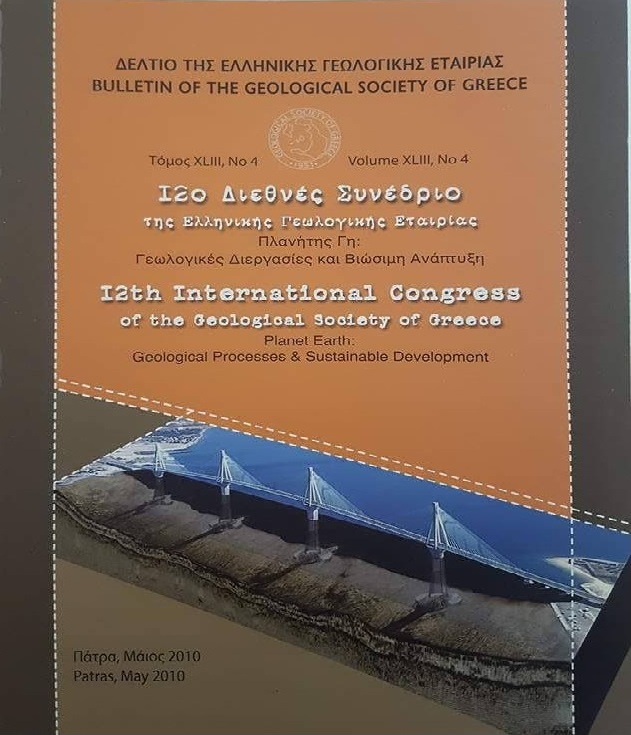ΓΕΩΦΥΣΙΚΗ ΔΙΑΣΚΟΠΗΣΗ ΣΤΟ ΟΡΟΠΕΔΙΟ TOY ΟΜΑΛΟΥ, Ν. ΧΑΝΙΩΝ
Περίληψη
Εξετάζονται και συγκρίνονται τα προκαταρκτικά αποτελέσματα γεωφυσικής διασκόπησης που πραγματοποιήθηκε στο οροπέδιο του Ομαλού στο νομό Χανίων, Κρήτης. Η γεωφυσική έρευνα περιελάμβανε μετρήσεις ηλεκτρικής τομογραφίας, ηλεκτρικής χαρτογράφησης, σεισμικής διάθλασης, γεωραντάρ, VLF, κινούμενου πομπού-δέκτη και τέλος βαρυτικής χαρτογράφησης. Στόχος της συγκεκριμένης μελέτης είναι η σύγκριση των αποτελεσμάτων των διαφόρων μεθοδολογιών που χρησιμοποιούνται για τον εντοπισμό και την απεικόνιση των καρστικών μορφών που συναντώνται στην περιοχή. Στην παρούσα μελέτη επομένως δίνεται έμφαση στη χρησιμότητα των γεωφυσικών μεθόδων στον εντοπισμό καρστικών δομών. Η επεξεργασία των δεδομένων επιτρέπει την αναγνώριση τριών γεωηλεκτρικών στρωμάτων που συνιστούν το γεωλογικό υπόβαθρο. Πρόκειται για το πρώτο στρώμα πολύ υψηλών ειδικών ηλεκτρικών αντιστάσεων, το οποίο χαρακτηρίζεται ως αλλουβιακές / διλλουβιακές αποθέσεις. Το δεύτερο στρώμα μειωμένων ηλεκτρικών αντιστάσεων που κατά κύριο λόγο αντικατοπτρίζει την ύπαρξη μαργών και τέλος το τρίτο γεωηλεκτρικό στρώμα, το οποίο με τη σειρά του οριοθετεί το ανθρακικό υπόβαθρο της περιοχής μελέτης. Ο συνδυασμός όλων των γεωφυσικών μεθόδων συγκλίνει στο ίδιο συμπέρασμα σχετικά με το πάχος των υπερκείμενων σχηματισμών του ανθρακικού υποβάθρου, το μέγιστο πάχος των οποίων είναι περίπου 115 m. Επίσης στο ανθρακικό υπόβαθρο εντοπίστηκαν δολίνες και καρστικά έγκοιλα σε ένα τμήμα του οροπεδίου του Ομαλού, όπου και πραγματοποιήθηκε η γεωφυσική διασκόπηση.
Λεπτομέρειες άρθρου
- Πώς να δημιουργήσετε Αναφορές
-
Βαφείδης Α., Μανούτσογλου Μ., Hamdan, H., Ανδρονικίδης Ν., Κουκαδάκη Μ., Κρητικάκης Γ., Οικονόμου Ν., & Σπανουδάκης Ν. (2004). ΓΕΩΦΥΣΙΚΗ ΔΙΑΣΚΟΠΗΣΗ ΣΤΟ ΟΡΟΠΕΔΙΟ TOY ΟΜΑΛΟΥ, Ν. ΧΑΝΙΩΝ. Δελτίο της Ελληνικής Γεωλογικής Εταιρείας, 36(3), 1204–1213. https://doi.org/10.12681/bgsg.16463
- Ενότητα
- Γεωφυσική

Αυτή η εργασία είναι αδειοδοτημένη υπό το CC Αναφορά Δημιουργού – Μη Εμπορική Χρήση 4.0.
Οι συγγραφείς θα πρέπει να είναι σύμφωνοι με τα παρακάτω: Οι συγγραφείς των άρθρων που δημοσιεύονται στο περιοδικό διατηρούν τα δικαιώματα πνευματικής ιδιοκτησίας επί των άρθρων τους, δίνοντας στο περιοδικό το δικαίωμα της πρώτης δημοσίευσης. Άρθρα που δημοσιεύονται στο περιοδικό διατίθενται με άδεια Creative Commons 4.0 Non Commercial και σύμφωνα με την οποία μπορούν να χρησιμοποιούνται ελεύθερα, με αναφορά στο/στη συγγραφέα και στην πρώτη δημοσίευση για μη κερδοσκοπικούς σκοπούς. Οι συγγραφείς μπορούν να: Μοιραστούν — αντιγράψουν και αναδιανέμουν το υλικό με κάθε μέσο και τρόπο, Προσαρμόσουν — αναμείξουν, τροποποιήσουν και δημιουργήσουν πάνω στο υλικό.





